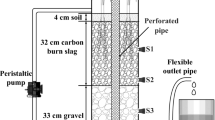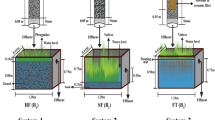Abstract
Four pilot-scale Vertical Flow Constructed Wetlands (VFCWs) filled with gravel and planted with Phragmites australis were operated for seven months in the field to study the efficiency of arsenic removal in contaminated wastewater. The average arsenic removal efficiency by the VFCWs was 52.0%±20.2%, 52.9%±21.3%, and 40.3%±19.4% at the theoretical concentrations of 50 µg/L (CW50), 100 µg/L (CW100), and 500 µg/L (CW500) arsenic in the wastewater, respectively. The results also showed no significant differences in the removal efficiency for conventional contaminants (nitrogen, phosphorus, or chemical oxygen demand) between wastewater treatments that did or did not contain arsenic (P>0.05), except for phosphorus in CW500. The highest average monthly removal rate of arsenic occurred in August (55.9%–74.5%) and the lowest in November (7.8%–15.5%). The arsenic removal efficiency of each VFCW was positively correlated with temperature (P < 0.05). Arsenic accumulated in both substrates and plants, with greater accumulation associated with increased arsenic concentrations in the influent. The maximum accumulated arsenic concentrations in the substrates and plants at the end of the experiment were 4.47 mg/kg and 281.9 mg/kg, respectively, both present in CW500. The translocation factor (TF) of arsenic in the reeds was less than 1, with most of the arsenic accumulating in the roots. The arsenic mass balance indicated that substrate accumulation contributed most to arsenic removal (19.9%–30.4%), with lower levels in plants (3.8%–9.5%). In summary, VFCWs are effective for the treatment of arsenic-containing wastewater.

Similar content being viewed by others
References
Ahoulé D G, Lalanne F, Mendret J, Brosillon S, Maïga A H (2015). Arsenic in African waters: A review. Water, Air, and Soil Pollution, 226(9): 302
Akinbile C O, Haque A M M (2012). Arsenic contamination in irrigation water for rice production in Bangladesh: A review. Trends in Applied Sciences Research, 7: 331–349
Alonso D L, Latorre S, Castillo E, Brandao P F (2014). Environmental occurrence of arsenic in Colombia: A review. Environmental Pollution, 186: 272–281
American Public Health Association (2005). Standard methods for the examination of water and wastewater. Washington, DC: American Public Health
Arroyo P, Ansola G, Miera L E S D (2013). Effects of substrate, vegetation and flow on arsenic and zinc removal efficiency and microbial diversity in constructed wetlands. Ecological Engineering, 51: 95–103
Avigliano E, Leisen M, Romero R, Carvalho B, Velasco G, Vianna M, Barra F, Volpedo A V (2017). Fluvio-marine travelers from South America: Cyclic amphidromy and freshwater residency, typical behaviors in Genidens barbus inferred by otolith chemistry. Fisheries Research, 193: 184–194
Bonanno G, Lo Giudice R (2010). Heavy metal bioaccumulation by the organs of Phragmites australis (common reed) and their potential use as contamination indicators. Ecological Indicators, 10(3): 639–645
Buddhawong S, Kuschk P, Mattusch J, Wiessner A, Stottmeister U (2005). Removal of arsenic and zinc using different laboratory model wetland systems. Engineering in Life Sciences, 5(3): 247–252
Bundschuh J, Litter M I, Parvez F, Roman-Ross G, Nicolli H B, Jean J S, Liu C W, Lopez D, Armienta M A, Guilherme L R, Cuevas A G, Cornejo L, Cumbal L, Toujaguez R (2012). One century of arsenic exposure in Latin America: A review of history and occurrence from 14 countries. Science of the Total Environment, 429: 2–35
Corroto C, Iriel A, Cirelli A F, Carrera A L P (2019). Constructed wetlands as an alternative for arsenic removal from reverse osmosis effluent. Science of the Total Environment, 691: 1242–1250
Dasgupta T, Hossain S A, Meharg A A, Price A H (2004). An arsenate tolerance gene on chromosome 6 of rice. New Phytologist, 163(1): 45–49
Gorme J B, Maniquiz M C, Lee S, Kim L H (2012). Seasonal changes of plant biomass at a constructed wetland in a livestock watershed area. Desalination and Water Treatment, 45(1–3): 136–143
He S, Wang X, Wu X, Yin Y, Ma L Q (2020). Using rice as a remediating plant to deplete bioavailable arsenic from paddy soils. Environment International, 141: 105799
Khaska M, Le Gal La Salle C, Verdoux P, Boutin R (2015). Tracking natural and anthropogenic origins of dissolved arsenic during surface and groundwater interaction in a post-closure mining context: Isotopic constraints. Journal of Contaminant Hydrology, 177–178: 122–135
Lage C R, Nayak A, Kim C H (2006). Arsenic ecotoxicology and innate immunity. Integrative and Comparative Biology, 46(6): 1040–1054
Li T, Fan Y, Cun D, Song X, Dai Y, Wang F, Wu C, Liang W (2020). Treatment performance and microbial response to dibutyl phthalate contaminated wastewater in vertical flow constructed wetland mesocosms. Chemosphere, 246: 125635
Liu S, Hou Y, Sun G (2013). Synergistic degradation of pyrene and volatilization of arsenic by cocultures of bacteria and a fungus. Frontiers of Environmental Science & Engineering, 7(2): 191–199
Lizama-Allende K, Fletcher T D, Sun G (2011). Removal processes for arsenic in constructed wetlands. Chemosphere, 84(8): 1032–1043
Lizama-Allende K, Fletcher T D, Sun G (2012). The effect of substrate media on the removal of arsenic, boron and iron from an acidic wastewater in planted column reactors. Chemical Engineering Journal, 179: 119–130
Lizama-Allende K, Jaque J, Ayala G, Montes-Atenas E, Leiva (2018). Arsenic removal using horizontal subsurface flow constructed wetlands: A sustainable alternative for arsenic-rich acidic waters. Water (Basel), 10(10): 1447
Lizama-Allende K, Mccarthy D T, Fletcher T D (2014). The influence of media type on removal of arsenic, iron and boron from acidic wastewater in horizontal flow wetland microcosms planted with Phragmites australis. Chemical Engineering Journal, 246: 217–228
Lu H, Li J, Liu X, Yu Z, Liu R (2019). Removal of fluoride and arsenic by a hybrid constructed wetland system. Chemistry & Biodiversity, 16(7): e1900078
Mochizuki H (2019). Arsenic neurotoxicity in humans. International Journal of Molecular Sciences, 20(14): 3418
Naujokas M F, Anderson B, Ahsan H, Aposhian H V, Graziano J H, Thompson C, Suk W A (2013). The broad scope of health effects from chronic arsenic exposure: update on a worldwide public health problem. Environmental Health Perspectives, 121(3): 295–302
Nicomel N R, Leus K, Folens K, Van Der Voort P, Du Laing G (2015). Technologies for arsenic removal from water: current status and future perspectives. International Journal of Environmental Research and Public Health, 13(1): ijerph13010062
Payne K B, Abdel-Fattah T M (2005). Adsorption of arsenate and arsenite by iron-treated activated carbon and zeolites: Effects of pH, temperature, and ionic strength. Journal of Environmental Science and Health, Part A: Toxic/Hazardous Substances & Environmental Engineering, 40(4): 723–749
Qi X, Li T, Wang F, Dai Y, Liang W (2018). Removal efficiency and enzymatic mechanism of dibutyl phthalate (DBP) by constructed wetlands. Environmental Science and Pollution Research International, 25(23): 23009–23017
Rahman K Z, Wiessner A, Kuschk P, Van Afferden M, Mattusch J, Müller R A (2011). Fate and distribution of arsenic in laboratory-scale subsurface horizontal-flow constructed wetlands treating an artificial wastewater. Ecological Engineering, 37(8): 1214–1224
Rahman K Z, Wiessner A, Kuschk P, Van Afferden M, Mattusch J, Müller R A (2014). Removal and fate of arsenic in the rhizosphere of Juncus effusus treating artificial wastewater in laboratory-scale constructed wetlands. Ecological Engineering, 69: 93–105
Ren W, Ni D, Liu Y, Yang G, Zhang H, Zhao L, Wang Y (2019). Accumulation and transportation of arsenic to wetland plant Typha angustifolia L. in the herbaceous plants grown in arsenic-contaminated habitat. Research of Environmental Science and Pollution, 32(5): 848–856 (in Chinese)
Rodríguez-Lado L, Sun G, Berg M, Zhang Q, Xue H, Zheng Q, Johnson C A (2013). Groundwater arsenic contamination throughout China. Science, 341(6148): 866–868
Roy M, Giri A K, Dutta S, Mukherjee P (2015). Integrated phytobial remediation for sustainable management of arsenic in soil and water. Environment International, 75: 180–198
Schwindaman J P, Castle J W, Rodgers J H Jr (2014). Fate and distribution of arsenic in a process-designed pilot-scale constructed wetland treatment system. Ecological Engineering, 68: 251–259
Singh A P, Goel R K, Kaur T (2011). Mechanisms pertaining to arsenic toxicity. Toxicology International, 18(2): 87–93
Singh R, Singh S, Parihar P, Singh V P, Prasad S M (2015). Arsenic contamination, consequences and remediation techniques: A review. Ecotoxicology and Environmental Safety, 112: 247–270
Singhakant C, Koottatep T, Satayavivad J (2009a). Enhanced arsenic removals through plant interactions in subsurface-flow constructed wetlands. Journal of Environmental Science and Health. Part A, Toxic/Hazardous Substances & Environmental Engineering, 44(2): 163–169
Singhakant C, Koottatep T, Satayavivad J (2009b). Fractional analysis of arsenic in subsurface-flow constructed wetlands with different length to depth ratios. Water Science and Technology, 60(7): 1771–1778
Soares Guimarães L H, Segura F R, Tonani L, Von-Zeska-Kress M R, Rodrigues J L, Calixto L A, Silva F F, Batista B L (2019). Arsenic volatilization by Aspergillus sp. and Penicillium sp. isolated from rice rhizosphere as a promising eco-safe tool for arsenic mitigation. Journal of Environmental Management, 237: 170–179
State Environmental Protection Administration (2002). Methods for monitoring and analysis of water and wastewater, 4rd edn. Beijing: China Environmental Science Press (in Chinese)
Su S, Zeng X, Bai L, Jiang X, Li L (2010). Bioaccumulation and biovolatilisation of pentavalent arsenic by Penicillin janthinellum, Fusarium oxysporum and Trichoderma asperellum under laboratory conditions. Current Microbiology, 61(4): 261–266
Sun G X, Williams P N, Carey A M, Zhu Y G, Deacon C, Raab A, Feldmann J, Islam R M, Meharg A A (2008). Inorganic arsenic in rice bran and its products are an order of magnitude higher than in bulk grain. Environmental Science & Technology, 42(19): 7542–7546
Sundberg-Jones S E, Hassan S M (2007). Macrophyte sorption and bioconcentration of elements in a pilot constructed wetland for flue gas desulfurization wastewater treatment. Water, Air, and Soil Pollution, 183(1–4): 187–200
Tanne N, Xu R, Zhou M, Zhang P, Wang X, Wen X (2019). Influence of pore size and membrane surface properties on arsenic removal by nanofiltration membranes. Frontiers of Environmental Science & Engineering, 13(2): 19
Taylor W (2000). Change-point analyzer 2.0 shareware program. Libertyville: Taylor Enterprises
USEPA (1996). Method 3050B: Acid digestion of sediments, sludges, and soils. Revision 2. Washington, DC: United States Environmental Protection Agency
Wang H, Li Y, Zhang S, Li D, Liu X, Wang W, Liu L, Wang Y, Kang L (2020). Effect of influent feeding pattern on municipal tailwater treatment during A sulfur-based denitrification constructed wetland. Bioresource Technology, 315: 123807
Wiessner A, Rahman K Z, Kuschk P, Kastner M, Jechorek M (2010). Dynamics of sulphur compounds in horizontal sub-surface flow laboratory-scale constructed wetlands treating artificial sewage. Water Research, 44(20): 6175–6185
Wu M, Li Q, Tang X, Huang Z, Lin L, Scholz M (2014a). Arsenic(V) removal in wetland filters treating drinking water with different substrates and plants. International Journal of Environmental Analytical Chemistry, 94(6): 618–638
Wu S, Kuschk P, Brix H, Vymazal J, Dong R (2014b). Development of constructed wetlands in performance intensifications for wastewater treatment: A nitrogen and organic matter targeted review. Water Research, 57: 40–55
Zhang S Y, Williams P N, Luo J, Zhu Y G (2017a). Microbial mediated arsenic biotransformation in wetlands. Frontiers of Environmental Science & Engineering, 11(1): 1
Zhang Z, Moon H S, Myneni S C B, Jaffé P R (2017b). Phosphate enhanced abiotic and biotic arsenic mobilization in the wetland rhizosphere. Chemosphere, 187: 130–139
Zhao J Y, Guo H M (2013). Study on arsenic removal in the simulating constructed wetland. Advanced Materials Research, 777: 386–389
Acknowledgements
This work was supported by grants from the Zhejiang Provincial Key R&D Program (2019C03110) and National Natural Science Foundation of China (Grant No. 51578538).
Author information
Authors and Affiliations
Corresponding author
Additional information
Highlights
• VFCWs are effective for the treatment of arsenic-containing wastewater.
• Arsenic removal did not affect the removal of nutrients, except for TP in CW500.
• Arsenic removal was highest when the temperature peaked and the reed was in bloom.
• Substrate accumulation contributed more to arsenic removal than plant absorption.
Rights and permissions
About this article
Cite this article
Fan, Y., Li, T., Cun, D. et al. Removal of arsenic by pilot-scale vertical flow constructed wetland. Front. Environ. Sci. Eng. 15, 79 (2021). https://doi.org/10.1007/s11783-021-1435-1
Received:
Revised:
Accepted:
Published:
DOI: https://doi.org/10.1007/s11783-021-1435-1




